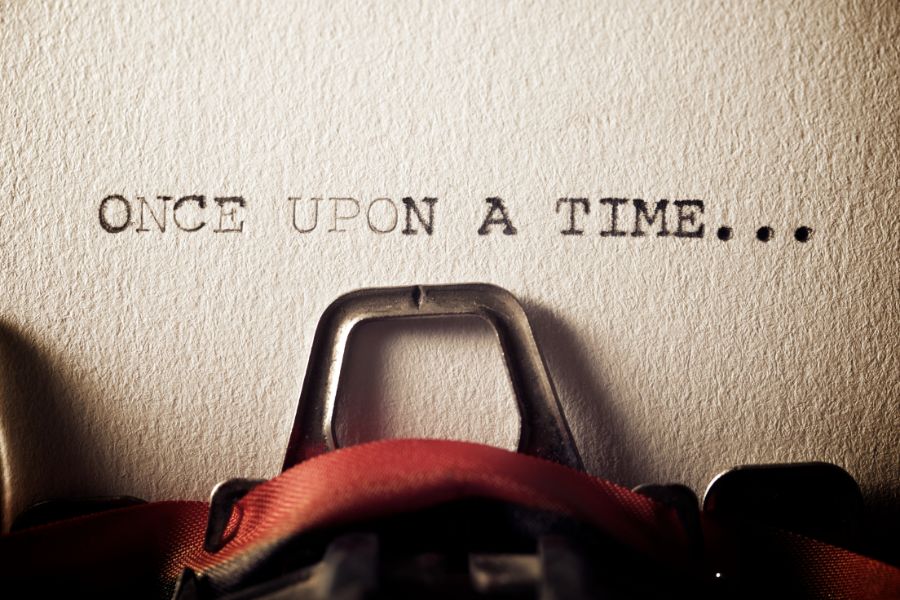It doesn’t matter if you’re writing a novel, short story, or any piece of creative writing, the right opening can make all the difference.
So how do you start your story the right way?
As an experienced writer and avid reader (with a short attention span!), I’m here to show you how to hook your reader and keep ’em glued to your story until the very end.
Ready to get started?
Let’s dig in.

Why Your Story’s Beginning Matters
The opening line of a story is the literary equivalent of a first impression.
Just as you wouldn’t show up to an important interview in pajamas, you wouldn’t want your story to have a lukewarm, forgettable entrance.
So, what exactly does a compelling start achieve?
- Setting the Stage: From the very first sentence, readers should be transported into the world of your story. Whether it’s a bustling cityscape, a tranquil village, or a spaceship hurtling through the cosmos, the environment sets the parameters for everything that follows.
- Establishing Tone: Is your story a somber reflection on loss? An exhilarating adventure? A biting satire? The opening provides those crucial cues, guiding readers’ expectations and preparing them for the emotional landscape ahead.
- Bonding with the Reader: In those initial moments, you’re forging a trust pact. Your audience is investing their time, hoping for a rewarding experience. A well-crafted beginning assures them they’re in capable hands.
- Laying the Groundwork: The start not only creates immediate engagement, it plants seeds for future developments. Themes, character motivations, central conflicts — all these can be subtly hinted at, priming readers for deeper exploration as the plot unfolds.
In other words, a great story beginning promises readers that the journey is worth their time. But what does it take to write an awesome start to your story?
10+ Successful Methods for Starting a Story

Every story begins by drawing the reader into a narrative web. Understanding and selecting the right technique can determine whether a reader turns the next page or closes the book.
So, let’s dive into methods that promise to capture readers’ imaginations right off the bat…
1. Begin with Purposeful Action
Jumping straight into action is like hitting a play button on super intense movie scene. It sets the tone and gets readers excited to read more and find out what happens next.
Think about James Bond in Ian Fleming’s novel, Live and Let Die — bullets fly before we even grasp the situation.
This immediate immersion compels readers to keep going, seeking the “why” behind the chaos.
It instantly grabs readers and makes them care about the outcome.
2. Create a Vivid Setting
In contrast to the dynamism of action, a compelling setting invites readers to immerse themselves in a world, letting the surroundings do the talking.
For example, think about the misty moors described in the opening paragraph of Emily Brontë’s Wuthering Heights, for example. This setting, bleak and foreboding, sets the stage for the tumultuous main story ahead.
Or think of the opening to J.K. Rowling’s Harry Potter and the Philosopher’s Stone, where the normalcy of Privet Drive is described in meticulous detail, only to be contrasted with the extraordinary events that follow.
When readers can visualize the world, they’re more anchored to the narrative. The stage is set, expectations are established, and the magic begins.
3. Introduce a Memorable Character

A memorable character introduction can captivate readers, making them invested from the get-go.
Think of Scarlett O’Hara in Gone With the Wind. From her first appearance, we know she’s a force to be reckoned with as we see her act out her confidence, her charm, and her defiance.
Her vivid portrayal lets us instantly know who we’re dealing with. A strong main character entrance can set the mood, tone, and pace for everything that follows. Have you ever met someone and instantly knew you’d never forget them? Yeah, it’s like that!
4. Start In Media Res
Starting your story with something unexpected is a bold statement. It tells the reader your story is about to be anything but ordinary.
An unexpected start promises readers a roller coaster of emotions, events, and revelations. Here’s how to harness this technique:
- Shock and Awe Readers: Think of Franz Kafka’s The Metamorphosis. Waking up to find oneself transformed into a gigantic insect is shocking, to say the least. Such a startling beginning ensures that readers are hooked, keen to understand the why and how of the situation.
- Flip Expectations: A clever way to create an engaging story is to present the familiar in an unfamiliar way. In George Orwell’s 1984, the line “It was a bright cold day in April, and the clocks were striking thirteen” immediately flips our understanding of reality, hinting at a world where normalcy is skewed.
- Use The Power of Mystery: Leaving an element of mystery or an unanswered question can make the beginning more intriguing. For example, J.D. Salinger’s The Catcher in the Rye as an illustration, the novel opens with Holden Caulfield mentioning his trip to the mental hospital, but not explaining why. This omission draws readers in, making them curious about the events that led to such a situation, urging them to read on to piece together the puzzle.
In other words, beginning your story in media res immerses readers into a world that piques their curiosity.
And by either shocking your readers, subverting their expectations, or presenting a tantalizing mystery, you ensure that they’re compelled to journey further into your story.
5. Establish Tone & Mood Immediately
From the get-go, setting a story’s tone and mood plants the reader firmly within your chosen atmosphere.
Take, for instance, Charlotte Brontë’s Jane Eyre, which begins, “There was no possibility of taking a walk that day.” This simple sentence conveys the bleakness and confinement that resonates throughout the novel.
A well-crafted mood ensures they’re not just reading but truly feeling the world you’ve constructed.
6. Begin With an Unexpected, Startling Statement
Catching your reader off-guard from the very first line can be a powerful way to pique their interest.
It pulls them into the narrative, eager to understand the context and uncover the meaning behind such a declaration.
Take Franz Kafka’s The Metamorphosis for example:
“Gregor Samsa woke up one morning from unsettling dreams to find himself transformed in his bed into a gigantic insect.”
Right from the start, the reader is left intrigued and perplexed. Such opening lines not only grab the readers attention but also set a tone that prepares readers for the unexpected twists and turns that the story might take.
7. Present a Central Conflict

Every captivating story contains a conflict — be it internal or external.
By introducing this struggle early on, you provide readers with a clear stake in the narrative, making them eager to see how it unfolds and resolves.
Consider the age-old conflict of man versus nature, as illustrated in Ernest Hemingway’s The Old Man and the Sea.
From the beginning, we are introduced to an old fisherman’s fierce determination to catch a giant marlin, setting up the central conflict of the main story.
When you introduce a pivotal conflict from the beginning, it not only lays the groundwork for character development and plot progression but also keeps readers glued to every page, anticipating the climax and resolution.
8. Hint at a Mystery
There’s something irresistibly alluring about a mystery.
By introducing an enigma or unanswered question right from the start, readers are instantly engaged, trying to unravel the puzzle alongside your characters.
Think about the haunting opening paragraph of Daphne du Maurier’s Rebecca:
“Last night I dreamt I went to Manderley again.”
Immediately, readers are propelled into a world of memories, wondering what Manderley is and why it’s so significant.
Mystery serves as a promise to the reader, a pledge that all will be revealed if they continue turning the pages.
9. Start With a Clear Theme or Message
Starting with a clear theme gives readers a heads-up about what’s coming.
Take Animal Farm by George Orwell, and its opening line:
“Mr Jones, of the Manor Farm, had locked the hen-houses for the night, but was too drunk to remember to shut the popholes.”
Straight away, Orwell subtly hints at the themes of neglect, power, and rebellion that are at the core of his story.
By making your theme evident from the start, you anchor your readers, giving them a lens through which to view the ensuing events, enriching their overall experience of the narrative.
10. Use a Striking Juxtaposition

Sometimes, the most effective way to capture your readers attention is by placing two contrasting elements side by side.
This juxtaposition can be thematic, character-based, or even scenic. By doing so, the inherent tension between these opposites can drive narrative interest.
For instance, in Charles Dickens’ A Tale of Two Cities, the famous opening line “It was the best of times, it was the worst of times…” immediately sets up a story of contrasts.
The stark differences not only spotlight the disparities within the tale but also invite readers to reflect on deeper meanings and implications. When utilized effectively, juxtaposition can be a profound tool in drawing readers into your narrative’s universe.
11. Open with a Unique Voice or Perspective
A story told from a distinctive viewpoint can provide fresh angles on familiar themes, ensuring that your narrative stands out in a sea of similar tales. For example:
- Employing Diverse Lenses: Books like The Curious Incident of the Dog in the Night-Time by Mark Haddon offer us a perspective through the eyes of an autistic protagonist, providing insights into a world many are unfamiliar with.
- Trying Out Nontraditional Historical Perspectives: Hilary Mantel’s Wolf Hall doesn’t just tell a historical story; it offers a unique perspective through its protagonist, Thomas Cromwell, a figure often relegated to the sidelines in many Tudor-era narratives.
- Playing with Narrative Voice: Books like If on a Winter’s Night a Traveler by Italo Calvino don’t just have a unique perspective; they play with the very idea of narration, breaking the fourth wall and making the reader a part of the story.
Starting with a unique voice or perspective not only adds depth to your story but ensures that it’s memorable.
And when done well, such narratives linger long after the last page has been turned, prompting reflection and discussion.
Pitfalls to Avoid When Starting a Story

A gripping beginning is crucial, but don’t forget to avoid common missteps that can repel readers.
Being aware of these pitfalls is critical to ensuring your story starts on the right foot.
- Overloading with Backstory: While it’s essential to provide context, an info dump at the start can be overwhelming. Remember Moby Dick by Herman Melville? While considered a masterpiece, its extensive details about whaling can deter some readers. A gradual revelation of background can be more engaging.
- Lack of Clear Direction: Starting with a vague or aimless scene can confuse readers. Your opening should give a hint of the narrative’s direction, even if it’s subtle.
- Forced Shock Factor: Starting with overly graphic or shocking content can feel gimmicky if it doesn’t serve the story. It’s about balance — a shocking start like the one in American Psycho by Bret Easton Ellis works because it aligns with the novel writing tone and theme.
- Being Overly Abstract: Philosophical or abstract openings can be intriguing, but they can also be alienating if readers can’t find a thread to hold onto. This is seen in critiques of James Joyce’s Finnegans Wake — a novel admired by many, but also noted for its challenging opening.
- Clichés and Overused Openings: Avoid starting with the protagonist waking up from a dream or an alarm clock buzzing unless there’s a fresh twist. Originality sets your story apart.
By dodging these pitfalls, you’ll ensure that your story’s opening not only grabs attention but also maintains it, setting the stage for a compelling narrative.
How to Recognize When the Start of Your Story is Ready
Armed with the above techniques, you now know how to start your story the right way.
Trust in your craft and the lessons you’ve gathered here.
What you’ve explored today are tools – not rules. They’re here to serve your storytelling and unique writing voice.
So lean into them. Experiment. The magic lies in taking what resonates and making it authentically yours.
Your story deserves to be heard. Let its opening be as unforgettable as you.




